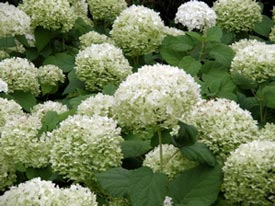Question: I am from Bahrain, which is hot and humid in summer. I would like to know if pigeon manure is good for fruit trees or not. Is it better than cow manure?
Answer: Great to hear from you. Congratulations to Bahrain on winning gold in the men's 1500 meter! Bird manures typically have higher nutrient levels than cow manure. Pigeon manure is used as a fertilizer and should be fine for your fruit trees. Be careful because in high quantities bird manures can cause fertilizer burn. You could mix your pigeon manure with cow manure and some leaf compost to minimize the risk of burn.
Click here for more information on fertilizing!

'Annabelle' hydrangea and other big-leaf hydrangeas can be moved without much trouble.
Question: A friend has a beautiful hydrangea bush that she has been trying to get rid of for a couple of years. She doesn't like it, but I love it! She said if I can move it, I can have it. Is there a safe way to move it to my yard? It's at least five years old and probably has some deep roots. Should I have a professional move it?
Answer: Fall is a great time to transplant shrubs, and hydrangeas are fairly easy. I'm assuming this is big-leaf hydrangea such as 'Annabelle'. Here are some guidelines:
Question: I am a fairly recent newcomer to the state of Washington where there is a significant amount of moss growing. I put my potted plants outside last summer but noticed after I brought them inside for the winter that moss was growing on top of the soil. I liked the way it looked, so I left it there. Some of my plants survived and some did not, so I am not certain if the moss had anything to do with their demise. Now I am wondering if it could have depleted the plants of oxygen or nutrients.
Answer: You are in one of my favorite states. Washington is a paradise for gardeners and naturalists. Moss does not have any true roots and absorbs all of its nutrients and water from the air, so it is not the cause of your plants' demise. But it may be a symptom. Most mosses (though not all) like acidic, infertile soil and high humidity, conditions that many plants cannot tolerate. What appears to have happened is simply that the moss liked the soil and environment in the pots more than your houseplants did.